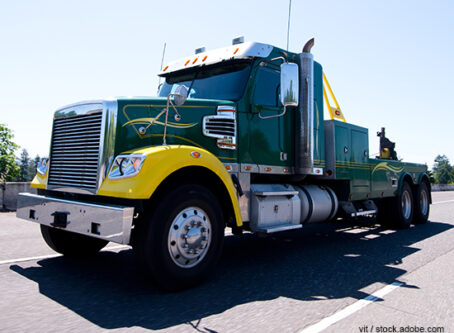Ag hauler denied H-2B truck driver application
A trucking company’s application for H-2B visa truck drivers was denied after it failed to include drivers’ routes and schedules for a request that otherwise may have been granted.
The Department of Labor’s Board of Alien Labor Certification Appeals has upheld the Employment and Training Administration’s decision to deny Altus, Okla.-based Salt Fork Transport’s application for H-2B truck drivers. Although the company’s argument regarding the definition of “worksite” is supported by precedent, the denial was due to it simply not providing requested information.
Salt Fork Transport is an ag hauler transporting cargo mostly between Oklahoma and Texas. In January, it filed an H-2B application seeking approval to hire three truck drivers for a seven-month period from April 1 through Oct. 30 under the seasonal-demand standard.
The trucking company undergoes peak demands during the fertilizer season (April to July) and harvest season (June to November).
Salt Fork Transport claims “finding qualified candidates continues to be its biggest challenge during its peak seasonal need.”
In February, the certifying officer found several required pieces of information were missing in the H-2B application, including details related to “area of intended employment,” which is defined as “the geographic area within normal commuting distance of the place (worksite address) of the job opportunity for which the certification is sought.”
Regulations require companies to submit one application for each worksite within one area of intended employment for each job opportunity. Area of intended employment needs to be specific enough to let job applicants know of any travel requirements and where applicants will likely have to reside to perform the job. The certifying officer requested Salt Fork Transport provide information about driving routes and schedules, including whether all workers begin and end each workday at the same location, to satisfy the requirement to inform applicants of travel.
Instead of providing specific routes and schedules, Salt Fork Transport submitted only its trucking terminal address, stating it is the only worksite location. The company was focusing on the previously debated topic of whether or not pickup and delivery locations are considered separate worksites.
Definition of H-2B ‘worksite’
When explaining why it submitted only the terminal address, Salt Fork Transport pointed to a previous H-2B truck driver case with a similar situation.
In 2019, the Board of Alien Labor Certification Appeals reversed a ruling denying Zolfo Springs, Fla.-based ATP Agri-Services its application for H-2B truck drivers. The certifying officer had denied the application on the basis that each pickup and delivery site was a separate worksite.
ATP Agri-Services relied on a separate H-2B truck driver application granted to Elmhurst, Ill.-based GT Trans in 2016. In that case, the appeals board found pickup/delivery locations are not worksites because “the job functions of a truck driver necessitate frequent changes of location with little time spent at any one location, and the nature of the occupation mandates a short-term presence.”
Since H-2B regulations do not define “workplace,” the board turned to H-1B regulations that find “place of employment” and “worksite” to be interchangeable.
However, the certifying officer denied ATP Agri-Service’s application based on guidance from the Office of Foreign Labor Certification (OFLC) that rejected the GT Trans finding. In guidance issued via a FAQ, OFLC states the following:
“If an employer seeks to employ tractor-trailer truck drivers to pick up and deliver cargo through routes across the United States, the job duties generally are not performed in one location. Rather, the job duties are performed in a number of locations across the United States and thus outside of a single area of intended employment. Accordingly, the job opportunity would not be eligible for H-2B certification.”
In its decision to reverse the denial, the appeals board rejected OFLC’s guidance. In addition to guidance being nonbinding, the board ruled that turning to legally binding definitions provided by a similar regulation (H-1B) makes more sense.
Additionally, the appeals board said that if every pickup/delivery location were a separate worksite, an H-2B applicant would be required to post a job notice at every location, including private property not owned by the company. Furthermore, contracts may not provide specific locations prior to an H-2B application filing. Essentially, the OFLC’s guidance would prevent trucking companies from participating in the H-2B program at all.
Since then, the only worksite location companies need to provide when applying for H-2B truck driver approval is the truck terminal.
Barking up the wrong tree
Although Salt Fork Transport may be correct in defining “workplace,” that was not what the certifying officer was asking for.
The trucking company was told to provide routes and schedules to address the issue of informing job applicants of any travel requirements and where they would need to reside. Nothing in the job order informs applicants how far, how long or where they would be required to travel.
Salt Fork Transport did not indicate what cities, counties or even states drivers would pass through. Rather, the company only recited quotes from the ATP Agri-Service case determining truck terminals are the sole worksite. But that was not the question at hand.
At best, the trucking company attached contracts that showed it would haul commodities to unspecified locations in South Texas and in the Southwestern U.S. The appeals board found that such generic information did not answer the question of where a driver is expected to work.
The appeals board even went as far as providing an example of what Salt Fork Transport could have said instead of regurgitating irrelevant case precedent.
“For example, employer might have stated something like: ‘We do not know right now the exact routes a driver will take, or the number of days a driver will be away from the trucking terminal; however, based on prior years and similar agricultural seasons, we anticipate a driver to be gone for x days and to mostly be driving between x-city and the trucking terminal.’”
In its decision upholding denial of the H-2B application, the appeals board acknowledged that the “worksite” interpretation is persuasive. However, the decision was based on Salt Fork Transport’s failure to respond to a question, not to address the worksite issue. Failing to respond to requests for information is sufficient grounds to support denial, regardless of any other factors in favor of the applicant. LL
Related stories:









